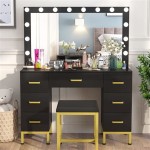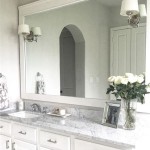What Is The Best Lighted Vanity Mirror?
Selecting the best lighted vanity mirror involves carefully considering numerous factors to ensure it meets individual needs and preferences. A well-chosen lighted vanity mirror can significantly enhance makeup application accuracy, skincare routines, and overall grooming experiences. This article explores key considerations and types of lighted vanity mirrors available, providing information to assist in making an informed decision.
The primary purpose of a lighted vanity mirror is to provide consistent and accurate illumination for the face. Adequate lighting allows for the precise application of makeup, ensuring even blending and color matching. It also aids in detailed skincare procedures, such as identifying blemishes requiring treatment or assessing skin texture for product effectiveness. Moreover, a quality lighted mirror can assist in grooming tasks like eyebrow shaping and hair styling, contributing to a polished and well-maintained appearance.
Key Considerations When Choosing a Lighted Vanity Mirror
Before exploring specific types or features, several fundamental considerations must be addressed to narrow down the optimal choice. These include lighting type, size and magnification, power source, mount type, and additional features.
Lighting Type: The type of lighting is arguably the most critical factor. Lighted vanity mirrors primarily utilize LED, incandescent, or fluorescent lighting. LEDs are generally favored due to their energy efficiency, long lifespan, and ability to produce a wide range of color temperatures. Incandescent bulbs, while offering a warm light, are energy-intensive and have a shorter lifespan. Fluorescent lights, though more energy-efficient than incandescent, can sometimes produce a harsh, unflattering light. The color temperature of the light, measured in Kelvin (K), is also important. Daylight (around 5000-6500K) is often recommended for makeup application as it most closely resembles natural outdoor lighting, providing accurate color representation.
Size and Magnification: The size of the mirror should be proportionate to the available space and the user’s needs. Smaller mirrors are suitable for travel or compact spaces, while larger mirrors offer a broader view of the face and upper body. Magnification is another crucial element. Mirrors with magnification, typically ranging from 5x to 10x, allow for detailed close-up work, such as applying eyeliner or plucking eyebrows. However, excessive magnification can distort the image and make it difficult to see the entire face at once. It is generally recommended to choose a magnification level that provides sufficient detail without significant distortion.
Power Source: Lighted vanity mirrors are typically powered by batteries, AC adapters, or a combination of both. Battery-powered mirrors offer portability but require regular battery replacement or recharging. AC-powered mirrors provide a consistent power supply but require proximity to an electrical outlet. Some mirrors offer both options, providing flexibility for different usage scenarios. When selecting a battery-powered mirror, consider the battery type (e.g., AA, AAA, lithium-ion) and battery life.
Mount Type: Lighted vanity mirrors come in various mount types, including tabletop, wall-mounted, and handheld. Tabletop mirrors are freestanding and can be easily moved around. Wall-mounted mirrors save counter space and are often adjustable for optimal viewing angles. Handheld mirrors offer maximum portability but require one hand to hold them in place. The choice of mount type depends on the available space, desired level of portability, and personal preferences.
Additional Features: Many lighted vanity mirrors offer additional features such as adjustable brightness, touch controls, Bluetooth connectivity, and built-in storage. Adjustable brightness allows users to customize the light intensity based on ambient lighting conditions. Touch controls provide a sleek and user-friendly interface. Bluetooth connectivity enables users to stream music or take calls through the mirror. Built-in storage compartments can be useful for organizing makeup brushes, applicators, and other small items. The value of these additional features depends on individual needs and preferences.
Types of Lighted Vanity Mirrors
Based on the considerations outlined above, lighted vanity mirrors can be categorized into several types, each with its advantages and disadvantages. These include tabletop vanity mirrors, wall-mounted vanity mirrors, travel vanity mirrors, and smart vanity mirrors.
Tabletop Vanity Mirrors: Tabletop vanity mirrors are the most common type of lighted vanity mirror. They are freestanding and can be placed on any flat surface, such as a vanity table, desk, or countertop. Tabletop mirrors typically offer a good balance of size, magnification, and features. Many models include adjustable brightness, multiple magnification options, and different lighting modes. Tabletop mirrors are generally easy to set up and use, making them a popular choice for home use.
Wall-Mounted Vanity Mirrors: Wall-mounted vanity mirrors are designed to be attached to a wall, saving valuable counter space. They are often found in bathrooms and dressing rooms. Wall-mounted mirrors typically offer adjustable arms and tilt mechanisms, allowing users to position the mirror at the optimal viewing angle. Some models also feature extendable arms, which allow the mirror to be pulled closer to the user. Wall-mounted mirrors are a good choice for those with limited counter space or who prefer a more permanent installation.
Travel Vanity Mirrors: Travel vanity mirrors are compact and lightweight, making them ideal for travel. They are typically battery-powered and feature foldable designs for easy storage. Travel mirrors often offer limited magnification and features compared to tabletop or wall-mounted mirrors. However, their portability makes them a valuable tool for maintaining a consistent grooming routine while on the go.
Smart Vanity Mirrors: Smart vanity mirrors are a relatively new category of lighted vanity mirrors that incorporate advanced technology. They often feature touch screens, Bluetooth connectivity, and built-in apps. Smart mirrors can display information such as weather forecasts, news headlines, and social media updates. Some models also offer facial recognition technology, which can analyze the user’s skin and recommend personalized skincare products. Smart mirrors can be a fun and convenient addition to a vanity setup, but they typically come at a higher price point.
Evaluating Light Quality and Color Accuracy
The quality of light emitted by a vanity mirror significantly impacts the accuracy of makeup application and the overall grooming experience. Light quality encompasses several factors, including color temperature, color rendering index (CRI), and light intensity. Understanding these factors allows for a more discerning selection process.
Color Temperature (Kelvin): Color temperature, measured in Kelvin (K), describes the warmth or coolness of a light source. Lower Kelvin values (e.g., 2700K) indicate a warmer, more yellow light, while higher Kelvin values (e.g., 6500K) indicate a cooler, more blue light. For makeup application, a color temperature of around 5000-6500K is generally recommended, as it closely mimics natural daylight. This allows for more accurate color matching and blending. Avoid using mirrors with overly warm or cool light, as these can distort the appearance of makeup.
Color Rendering Index (CRI): The Color Rendering Index (CRI) measures how accurately a light source renders the colors of objects compared to natural daylight. A CRI of 100 indicates perfect color rendering, while a CRI of 0 indicates poor color rendering. For makeup application and skincare, a mirror with a CRI of 90 or higher is recommended. This ensures that colors appear true to life and that subtle differences in skin tone and texture are visible.
Light Intensity (Lumens): Light intensity, measured in lumens, refers to the brightness of the light source. The appropriate light intensity depends on the ambient lighting conditions and the user’s preferences. Mirrors with adjustable brightness settings are ideal, as they allow users to customize the light intensity based on their needs. In general, a light intensity of around 800-1200 lumens is sufficient for makeup application and skincare. However, those with visual impairments may require a higher light intensity.
When evaluating light quality, it is important to consider all three factors: color temperature, CRI, and light intensity. A mirror with a balanced combination of these factors will provide the most accurate and flattering illumination for makeup application and skincare.

Best Lighted Bathroom Mirrors To Buy In 2024

How To Choose The Best Lighted Vanity Mirrors For Bathroom Ledmyplace
Led Vanity Mirror Best Makeover Experience Accent

Best Led Vanity Mirrors Of 2024 In Toronto Bliss Bath Kitchen

7 Best Makeup Mirrors With Lights Of 2024 Reviewed

15 Best Lighted Makeup Mirrors Of 2024

9 Best Lighted Makeup Mirrors 2024 The Strategist

The 4 Best Lighted Makeup Mirrors Of 2024 Reviews By Wirecutter
:max_bytes(150000):strip_icc()/Fanciiledlightedmakeupvanitymirrorschrome_400x-df512cbd4844419f877ca1e4c237edb3.jpg?strip=all)
The 11 Best Lighted Makeup Mirrors 2024 Tested And Reviewed

9 Best Lighted Makeup Mirrors 2024 The Strategist








